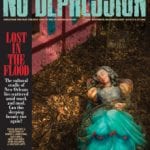Hello Stranger from Issue #60
Sorting through dozens of options for a photograph that could represent our coverage of Hurricane Katrina’s effect on New Orleans music and culture, Grant spotted an arresting shot that was unlike anything else under consideration. Resting next to a little pink house amid a landscape strewn with mud, leaves and debris was a statue of a young woman seemingly lifted straight out of a Disney classic, awash in bright colors even as everything around her was drowning in brown and black flotsam and jetsam.
Abstract though it was, the picture spoke to me from the moment I laid eyes on it. Something about the tone of the image seemed to articulate, in emotional terms, the sense of loss that was being documented on the TV news every night for basically the entire month of September. The flooded streets, the flattened houses, the floating bodies, the desperate throngs of residents stranded in New Orleans — it was all so much, it became almost impossible to comprehend the enormity of the destruction. And then there was this simple little picture.
Photographer Brian Baiamonte, a native of the Baton Rouge area who managed to visit New Orleans several times (initially on search and rescue) shortly after Katrina and took a great number of shots across the devastated city, several of which accompany our package that begins on page 66. We asked Brian to provide us with a little background and further details about the photo. He explained that the statue was meant to be a likeness of Sleeping Beauty, and that it was part of Storyland, a popular children’s section of New Orleans City Park, one of the city’s longtime outdoor institutions.
“Storyland consists of a small village of fiberglass or concrete figures representing characters from fairy tales and nursery rhymes,” Baiamonte wrote in an e-mail. “Kinda like a goofy golf course without the golf. My grandparent took me there when I was a young child, so it has been there for at least 25 years.
“For me, the image is a sort of innocence lost with a double meaning, dealing with New Orleans being a ‘sleeping beauty’ of sorts. It is so quiet and empty, it is as if the city were asleep.”
The local travelogue was helpful and appreciated, as I’d wondered what the story was behind the setting and the scene. As for his emotional response — well, I already knew exactly what he meant, for this was precisely the feeling that his photo had brought about in me.
The effect, I’m certain, resonates more deeply with Brian. Those of us watching from afar can sympathize, but I don’t think most of us can really imagine the sense of loss the locals must feel — not just of possessions, but of neighborhoods, of landscapes, of relationships, of communities, of precious time that must now be spent simply watching, waiting, wondering what the future holds for their city, their home.
We hope that our dispatches from three musicians — Mary Gauthier, Peter Holsapple and Grayson Capps — with deep roots in the area will help to provide some of that perspective. Frequent ND contributor Robert L. Doerschuk spoke with others about their own personal stories, and New Orleans journalist Alex Rawls offered insights about the effect of the disaster on the city’s cultural infrastructure.
Some of this, inevitably, traverses a little ways into politics, for the rebuilding efforts will be affected by decision-makers in Washington and elsewhere. Foremost, though, our desire was to underscore New Orleans’ indelible influence on the music we endeavor to cover in these pages every two months — and to try to comprehend what all of us stand to lose, if the Crescent City is not supported and nurtured properly toward recovery.
As we announced in early September via an e-mail blast to those who’ve signed up to get them on our website, No Depression is contributing $1,000 to the Red Cross to aid in hurricane relief efforts. My wife spent much of the past week attending Red Cross training sessions for possible deployment to the disaster zone; her experiences confirmed to me that the organization needs all the assistance it can get to deal with the unprecedented scope of the Gulf Coast’s situation.
If you wish to contribute specifically to an organization assisting musicians affected by Katrina, our correspondent Peter Holsapple recommends visiting www.nomrf.org, the website of the New Orleans Musicians Relief Fund. Alex Rawls recommends Project HEAL (www.acadianartscouncil/org) and Tipitina’s Foundation (www.tipitinas.com).




